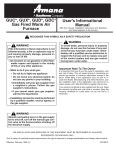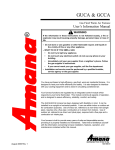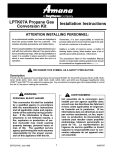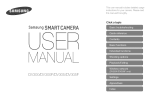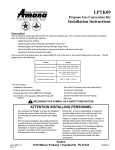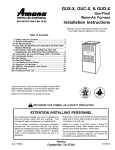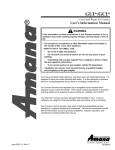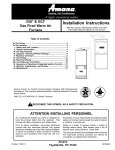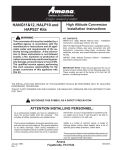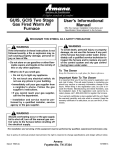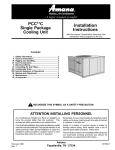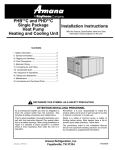Download Amana GUC Series Specifications
Transcript
GUC*, GUX*, GUD*, GDC*, GDC* ® Gas-Fired Warm Air Furnace ™ User's Information Manual Affix this manual, Specification Sheet and Installation Instructions adjacent to the furnace. WARNING WARNING WARNING If the information in these instructions is not followed exactly, a fire or explosion may result causing property damage, personal injury or loss of life. – Do not store or use gasoline or other flammable vapors and liquids in the vicinity of this or any other appliance. – What to do if you smell gas: • Do not try to light any appliance. • Do not touch any electrical switch; do not use any phone in your building. • Immediately call your gas supplier from a neighbor’s phone. Follow the gas supplier’s instructions. • If you cannot reach your gas supplier, call the fire department. – Installation and service must be performed by a qualified installer, service agency or the gas supplier. To avoid death, personal injury or property damage, do not use this furnace if any part of the furnace has been under water. Immediately call a qualified service technician to inspect the furnace and to replace any part of the control system and any gas control having been under water. Important Note To The Owner It is important that you fill out the owner’s registration card and mail it today. This will assist Amana in contacting you should any service or warranty information change in the future. When filling in the registration card, be sure to include the Model, Manufacturing and Serial Numbers, plus the installation date. If the registration card cannot be located, please call 1-800-843-0304 to register the furnace. Your warranty certificate is also supplied with the unit. Read the warranty carefully and note what is covered. Keep the warranty certificate in a safe place, so you can find it, if necessary. Before using this manual, check the serial plate for proper model identification. WARNING Should overheating occur or the gas supply fail to shut off, turn off the manual gas control valve to the furnace before shutting off the electrical supply. RECOGNIZE THIS SYMBOL AS A SAFETY PRECAUTION THE INSTALLATION AND SERVICING OF THIS EQUIPMENT MUST BE PERFORMED BY QUALIFIED, EXPERIENCED TECHNICIANS ONLY. Due to policy of continual product improvement, the right is reserved to change specifications and design without notice. June 1999 (2) Amana Fayetteville, TN 37334 10318817 Table of Contents Important Note To The Owner ........................................................................................................................... 1 I. General Information ..................................................................................................................................... 3 II. Operation ...................................................................................................................................................... 5 III. Maintenance ................................................................................................................................................. 8 IV. Inspection of Furnace (Qualified Servicer Only) .................................................................................... 10 V. For More Information .................................................................................................................................. 11 VI. Safety Labels .............................................................................................................................................. 12 ATTENTION INSTALLING PERSONNEL As a professional installer you have an obligation to know the product better than the customer. This includes all safety precautions and related items. Remember, it is your responsibility to install the product safely and to know it well enough to be able to instruct a customer in its safe use. Prior to actual installation, thoroughly familiarize yourself with this manual. Pay special attention to all safety warnings. Often during installation or repair it is possible to place yourself in a position which is more hazardous than when the unit is in operation. Safety is a matter of common sense...a matter of thinking before acting. Most dealers have a list of specific good safety practices...follow them. The precautions listed in this manual should not supersede existing practices but should be considered as supplemental information. Remember to leave this manual with the homeowner. 2 WARNING I. General Information To avoid personal injury or fire, minimum clearances to combustible surfaces must be followed. This furnace is built to provide many years of safe and dependable service, providing it is properly installed and maintained. However, abuse and/or improper use can shorten the life of the furnace and create hazards for you, the homeowner. 7. Make certain the required clearances for the furnace are always maintained. These clearances are listed on the furnace nameplate. If any question develops, contact the installer of the furnace, or another qualified servicer. WARNING This product contains or produces a chemical or chemicals which may cause serious illness or death and which are known to the State of California to cause cancer, birth defects or other reproductive harm. UNIT INSTALLATION Examine the furnace installation to determine the following: 1. The flue vent pipe is physically sound and sealed. The vent slopes upward to vent terminal so condensate drains back toward the furnace. The vent shows no evidence of leaking or separation at joints or fittings. 2. The return air duct connection is physically sound, sealed to the furnace casing, and terminates outside the space containing the furnace. 3. The physical support of the furnace is sound without sagging, cracks, or gaps around the base so as to provide a seal between the support and the base. 4. There are no obvious signs of deterioration of the furnace. 5. Check the burner flames for adjustment. WARNING To avoid possible equipment damage, personal injury, fire or death, the following instructions must be observed regarding unit location, air requirements and operating procedures. UNIT LOCATION 1. The furnace area and the vicinity of any other gas appliances must be kept clear and free of combustible materials, gasoline, and other flammable vapors and liquids. Also, do not store or use flammable items such as paint, varnish, or lacquer in the area. 2. Do not store or use chlorine or fluorine products (bleaches, cements, strippers, aerosols) near the unit. They can corrode the heat exchanger. 3. Do not use the furnace closet as storage for brooms, mops, brushes and oily rags or cloths. The area must be kept clear, clean and free of lint. Furnace must be kept free and clear of exposed or loose insulation materials in the area of installation. Examine the furnace area when the furnace or additional insulation is added since some insulation materials may be combustible. 4. Make sure the furnace is always connected to an approved vent, in good condition, to carry combustion products outdoors. 5. Familiarize yourself with the controls that shut off the gas and electrical power to the furnace. If the furnace is to be shut down at the end of the heating season, turn off both the gas and electrical power. For safety, always turn the gas and electrical power off before performing service or maintenance on the furnace. 6. Establish a regular maintenance schedule to insure efficient and safe operation of the furnace. The furnace should be checked at the beginning of each heating and cooling season by a qualified service technician. MINIMUM UNIT CLEARANCES TO COMBUSTIBLE SURFACES (UPFLOW AND COUNTERFLOW INSTALLATIONS) NOTE: GDC and GCD models require special subbase when installed on combustible (wood only) floor (CFSB16, 20 or 24). 0" A 1" Top Clearance is also required 1" 1" 3" Service Area 36" Free Access To Furnace Figure 1 Upflow and Counterflow Clearances (Top View) 3 WARNING MINIMUM UNIT CLEARANCES TO COMBUSTIBLE SURFACES (HORIZONTAL INSTALLATIONS - GDC ONLY) A SIX INCH TOP CLEARANCE IS ALSO REQUIRED. 0" 0" 6" 6" 12" 12" Alcove Left Air Discharge It is vitally important that the furnace have proper venting. GUC, GUX, GUD, GDC or GCD model furnaces must never be common vented with another gas fired appliance. Any alteration to any venting system must be in accordance with local and national codes, and the manufacturer's instructions. COMBUSTION AIR (GUC, GUX, GUD, GDC AND GCD ONE PIPE SYSTEM) Normally the air for combustion and ventilation can be obtained from the surrounding unconfined space or louvered closet door. • When a furnace is installed in a closet and the closet door is louvered DO NOT OBSTRUCT LOUVERS. Louvers must be open and clear to provide combustion air to the furnace. • When the furnace is installed in a confined space within a home and the air for combustion and ventilation enters the space through ducts from the outside...be sure to check the entering and outlet (grilled) openings so that they are always clear and clean. Alcove Right Air Discharge Figure 2 Horizontal Clearances (GDC) AIR REQUIREMENTS WARNING To avoid death, personal injury or property damage, enough fresh air for proper combustion and ventilation of flue gases must be provided to this furnace. Most homes require outside air to be supplied into the furnace area. IMPORTANT NOTE: Do not partition off a small area around the furnace including a non louvered door. This could obstruct the combustion air from reaching the furnace. Improved construction and additional insulation in homes have reduced the heat loss and made these homes much tighter around doors and windows so that air infiltration is minimal. This creates a problem to supply ventilation and/ or combustion air for gas fired or other fuel burning appliances. Any use of appliances that pull air out of the house (clothes dryers, exhaust fans, fireplaces, etc.) increases this problem and appliances could be starving for air. COMBUSTION AIR (GUD AND GCD - TWO PIPE SYSTEM) NOTE: To insure proper operation of the furnace, both combustion air and flue pipes must never become obstructed. NOTE: The air for combustion and ventilation must not come from a corrosive atmosphere. If fuel-burning appliances are starved for air, the flue gases which these appliances produce as they operate may not vent outdoors properly, but remain in the home instead. These flue gases may include carbon monoxide. WARNING To prevent possible death or personal injury due to asphyxiation, Amana Condensing Gas Fired Warm Air Furnaces must be Category IV vented. WARNING Death or personal injury from asphyxiation can result from exposure to carbon monoxide. Category IV venting must be gas and water tight. For information on Category IV venting, refer to the installation instructions available from the installing dealer, distributor, or directly from Amana. Carbon monoxide or “CO” is a colorless and odorless gas produced when fuel is not burned completely or when the flame does not receive sufficient oxygen. Be aware of these air starvation signals which indicate conditions that may result in carbon monoxide or that carbon monoxide may be present: 1. Headaches-Nausea-Dizziness. 2. Excessive humidity-heavily frosted windows or a moist “clammy” feeling in the home. 3. Smoke from a fireplace won’t draw up the chimney. 4. Flue gases won’t draw up the appliance vent pipe. 4 The vent system must slope toward the furnace for drainage of condensate. Provision must be made to drain the condensate and protect the condensate drain trap and drain line from freezing conditions. PROPANE FURNACES ONLY WARNING To avoid death, personal injury or property damage due to explosion or fire, install a gas detecting warning device. Since the odorant in propane gas can be reduced by iron oxide (rust), a gas detecting warning device is the only reliable method to detect propane gas leaks. WARNING To prevent possible death or personal injury due to asphyxiation, common venting with other induced draft appliances is not allowed. Carefully read and follow all instructions given in this section. WARNING NOTE: The louvers in the furnace door and top must never be obstructed. They must remain open so air can flow through the furnace and cool internal components. If the gas furnace is installed in a basement, an excavated area or a confined space, it is strongly recommended to contact a propane supplier to install a gas detecting warning device in case of a gas leak. • Since propane gas is heavier than air, any leaking gas can settle in any low areas or confined spaces. • Propane gas odorant may fade, making the gas undetectable except with a warning device. An undetected gas leak will create a danger of explosion or fire. If the presence of gas is suspected, follow the instructions on the cover of this manual. Failure to do so could result in SERIOUS PERSONAL INJURY OR DEATH. INDOOR HUMIDITY Relative humidity is the amount of water vapor in the air relative to the amount the air can hold at the same temperature. Example: At 40% relative humidity, the air could hold 2 1/2 times as much moisture (2.5 x 40 = 100%) before becoming saturated. The colder the air; the less moisture it can hold. As air is warmed, its ability to hold moisture is increased. Example: A winter day, outdoor temperature 10°F, and relative humidity of 70%. If that air enters a home and is warmed to 72°F the relative humidity will drop to 6% (very dry) if no more moisture is added. Relative humidity is important to your health and home as proper humidification helps reduce respiratory difficulties and helps improve the indoor air quality. A good relative humidity is one just high enough to barely start condensation along the lower edges or lower corners of the windows. More than that can be damaging. II. Operation THERMOSTAT There are many types and styles of thermostats but the operation is usually similar. BE SURE TO BECOME FAMILIAR WITH YOUR THERMOSTAT. The simplest type of thermostat only starts and stops the furnace to maintain the proper room temperature. The most widely used types will control both heating and cooling functions and will have a Fan Switch with Auto and ON settings. On Auto, the circulating air blower will cycle on/off with the furnace but if switched to ON it will run constantly whether or not the furnace is on. Frequent fogging or excessive condensation on inside windows indicates the indoor humidity level is too high for outdoor weather conditions. Damage to the building may result if the condition persists. (Condensation on inside of storm windows indicates loose inside windows. Adding weather-stripping to tighten inside windows usually corrects this problem.) The following table shows the recommended maximum indoor humidity in relationship to the outdoor temperatures. Temperature (° F.) +20° +10° 0° -10° -20° Humidity In addition there are thermostats that automatically switch from Heating to Cooling and with night setbacks. The night set-back, or multiple set-back type, will lower the temperature at night or during the day when no one is at home. 35% 30% 25% 20% 15% Table 1 5 Room Temperature Thermostat Cool/Heat Temperature Control Dial 5. This furnace is equipped with an ignition device which automatically lights the burner. Do not try to light burner by hand. 6. White Rodgers Model 36E36 or 36E37 or Honeywell Model VR-8205: Turn the gas control knob clockwise to the OFF position for either the White Rodgers gas valve (Figure 4) or the Honeywell gas valve (Figure 5). White Rodgers Model 36E22 or 36E23: Push the selector switch to "OFF". (Figure 6) 7. Wait five minutes to clear out any gas. Then smell for gas, including near the floor. This is important , because some types of gas are heavier than air. 8. If you smell gas following the five minute waiting period in Step 7, immediately follow the instructions on the cover of this manual. If you do not smell gas after five minutes: White Rodgers Model 36E36 or 36E37 or Honeywell Model VR-8205: Turn the gas control knob counterclockwise to the ON position for either the White Rodgers 36E gas valve (Figure 4) or the Honeywell VR8205 gas valve (Figure 5). White Rodgers Model 36E22 or 36E23: Push the selector switch to "ON". (Figure 6) 9. Replace the door on the front of the furnace. 10. Open the manual gas valve external to the furnace. 11. Turn on the electrical power supply to the furnace. 12. Set thermostat to desired setting. Thermostat Control Lever Cool/Heat Switch Fan Switch System Switch OFF Fan Switch AUTO COOL AUTO COOL ON HEAT AUTO HEAT ON OFF ON Action None System only cools, fan cycles off and on. System only cools, fan runs all the time. System only heats, fan cycles off and on. System only heats, fan runs all the time. No heating or cooling, fan runs all the time. Figure 3 Typical Thermostat ELECTRICAL COMPONENTS This furnace is equipped with an electronic ignition device which lights the burners. It also has a induced draft blower to exhaust combustion products. Keep both doors in place except for inspection and maintenance. An interlock switch prevents furnace operation if the blower door is not in place. Figure 4 White Rodgers Models 36E36 or 36E37 Do not use this furnace if any part has been under water. Immediately call a qualified servicer to inspect the furnace and to replace any part of the control system and any gas control which has been under water. WARNING To avoid death, personal injury or property damage do not remove any internal compartment covers. Electrical components are contained in both compartments. Contact a qualified servicer at once if an abnormal condition is noticed. OPERATING INSTRUCTIONS 1. Close the manual gas valve external to the furnace. 2. Turn off the electrical power supply to the furnace. 3. Set room thermostat to lowest possible setting. 4. Remove the louvered door on the front of the furnace by turning the latch screw 1/4 turn. Figure 5 Honeywell Model VR-8205 6 WR Redundant Solenoid O F F INLET M 1 P 3 C 2 Main Solenoid OUTLET ON ON/Off Switch Inlet Pressure Tap (Side of Valve) Main Regulator Adjust Outlet Pressure Tap (Side of Valve) Flame Roll-Out Protection Device Figure 6 White Rodgers Model 36E22 or 36E23 ROLL-OUT PROTECTION DEVICE If flames from the burners are not properly drawn into the heat exchanger, a flame roll-out limit switch will open causing combustion to cease. This limit switch must be reset manually. The roll-out limit switch is located on one end of the manifold assembly for GUC, GUX and GDC furnaces (Figure 7 and 8) and in the burner box on GUD and GCD furnaces (Figure 10). GDC furnaces installed horizontally must have the roll-out limit switch located at the top end of the manifold assembly. (Figure 9) Figure 8 Roll-Out Protection Device - Counterflow Position (GDC) AUXILIARY LIMIT CONTROL (GDC AND GCD ONLY) A second limit control is located on one side of the indoor air blower. (Figure 11) Disconnect electrical power prior to removing the non-louvered door to reach the secondary limit control. The control is in addition to the main control and shuts the furnace off in case of a blower failure. This control is a manual reset control, which can be reset only once. If the unit goes off on limit a second time, contact a qualified servicer so the problem causing the control to open can be corrected. Flame Roll-Out Protection Device Figure 9 Roll-Out Protection Device - Horizontal Position (GDC) Flame Roll-Out Protection Device Flame Roll-Out Protection Device Figure 7 Roll-Out Protection Device (GUC and GUX) Figure 10 Roll-Out Protection Device (GUD and GCD) 7 Horizontal Left Air Discharge (GDC) RESET AFTER CONTROL LOCK-OUT If ignition has not been achieved for any reason after three ignition cycles, the electronic control module will lock-out the furnace. Ignition is no longer attempted. The control's diagnostic light will then repeatedly flash once and then pause. When this occurs, it may be necessary to reset the control by turning the thermostat setting below room temperature for thirty seconds and then returning the setting to the desired temperature. The control may also be reset after a lock-out by turning off the electrical disconnect switch to the furnace for thirty seconds. The control will automatically reset after one hour. Counterflow (GDC and GCD) and Horizontal Right (GDC) Air Discharge Blower Assembly Transformer Control Board IMPORTANT: If the furnace must be reset frequently to obtain satisfactory operation, a problem exists with your furnace that must be corrected. Contact a qualified servicer. Figure 11 Auxiliary Limit Control Position (GDC and GCD) III. Maintenance AT LEAST ONCE A YEAR, BEFORE THE HEATING SEASON BEGINS, have the furnace checked by a qualified servicer to be certain there is adequate combustion air and that the furnace and the vent system are working properly. WARNING To avoid death, personal injury or property damage due to fire or explosion, do not reset the roll-out protection device. If it opens, the cause must be investigated by a qualified servicer before any attempt is made to engage the roll-out protection device and turn the furnace back on. Have the vent pipe and combustion air pipe (some models) checked for blockage by debris or leaks, which could permit fumes to enter the house. Replace any damaged sections of the vent pipe. WARNING TURNING OFF FURNACE 1. Set the thermostat to lowest setting. 2. Turn off the electrical power supply to the furnace. 3. Remove the louvered door on the front of the furnace by turning the latch screws 1/4 turn each. 4. White Rodgers Model 36E36 or 36E37 or Honeywell Model VR-8205: Turn the gas control knob clockwise to the OFF position for either the White Rodgers gas valves (Figure 4) or the Honeywell gas valve (Figure 5). White Rodgers Model 36E22 or 36E23: Push the selector switch to "OFF". (Figure 6) 5. Close manual gas shut-off valve external to the furnace. 6. Replace the door on the furnace. To avoid death or personal injury due to electrical shock, disconnect the electrical power before performing any maintenance. REPLACING OR CLEANING FILTERS WARNING To avoid death, personal injury or property damage, never operate furnace without a filter installed. Dust and lint will build up on internal parts resulting in loss of efficiency, equipment damage and possible fire. If filter replacement becomes necessary, it must be replaced with a filter of the same type and size that complies with UL900 or CAN/ULC-S111 standards. ELECTRONIC CONTROL MODULE The furnace is equipped with a self-diagnostic electronic control module. If a furnace component is not operating properly, the control module will repeatedly flash a red light on and off in a factory-programmed sequence, depending on the problem encountered. See the Specification Sheet for filter sizes. WARNING To avoid death or personal injury due to electrical shock, disconnect the electrical power before removing filters or performing any maintenance. If a furnace equipped with a self diagnostic module is not operating properly, look through the observation window in the blower access door and make note of the number of flashes in the sequence. Contact a qualified servicer for further information. Do not attempt to troubleshoot the problem yourself. The filter is designed for high velocity heating and cooling applications. Filters must be inspected, cleaned or changed every two months or as required. It is the owner's respon8 sibility to keep air filters clean. NOTE: Dirty filters are the most common cause of inadequate heating or cooling performance. FILTER CLEANING AND REPLACING Use a vacuum cleaner to clean out the blower area and the adjacent area of the return air duct. UPFLOW FILTERS (GUC, GUX, AND GUD) To remove the filter contained in the furnace retaining rails, disconnect electrical power to the furnace and remove the lower door by turning the door latches 1/4 turn. Wash, rinse, and dry a permanent filter. Both sides of a metal filter should be sprayed with a dust adhesive as recommended on the adhesive container. Spray adhesives for use with permanent metal filters can be found at some hardware stores. Grasp the lower portion of the filter, lift up to disengage it from the lower railing, move towards blower, drop filter down. Pull filter outward. (Figure 12) If permanent filters are badly torn or uncleanable, they must be replaced with permanent filters of the same type and size. SIDE AIR RETURN 1. Lift filter above bottom rail. When replacing permanent filter used in side air return applications, the filter must have dimensions of 16" x 25" x 1". 2. Tilt filter to clear rail. When replacing permanent filter used in bottom air return applications replace with same size and type permanent filter. Front of Furnace Front of Furnace Reinstall filter by placing it into the furnace along the side of the blower. Engage filter in top rail, move toward side of furnace and drop it into the bottom rail. BE SURE AIRFLOW DIRECTION ARROW POINTS TOWARDS THE BLOWER. Blower Filter Blower COUNTERFLOW FILTERS (GDC AND GCD) This manual discusses the furnace mounted filter rack which is shipped with the furnace. Other filter arrangements could have been used. Grab Here And Lift 3. Lower filter below top rail. 4. Pull filter out. Front of Furnace Front of Furnace Blower Blower Figure 12 Filter Removal Figure 14 Counterflow Furnace Mounted Filter Rack BOTTOM AIR RETURN (GUC, GUX, AND GUD) The filter is held in place by a sheet metal retainer strap (Figure 13). To change and clean the filter, slide one end of the retainer toward the front and remove filter. Remember dirty filters are the most common cause of inadequate heating or cooling performance. The furnace-mounted filter rack includes a rack mounted on the top of the furnace. Two filters fit into the rack and rest against the sides of the return air plenum, forming a “V” above the furnace. (Figure 14) Figure 13 Filter Retainer 9 The filters should be inspected and cleaned or changed every two months or as required. In some installations, the filters can be inspected and cleaned or changed after disconnecting the electrical power and removing the optional access door in the return air plenum. If the installation does not have an access door proceed as follows: AIR CIRCULATING BLOWER MOTOR LUBRICATION The air circulation blower motor bearings are permanently lubricated. No further lubrication is required. IV. Inspection of Furnace (Qualified Servicer Only) 1. Disconnect the electrical power. 2. Remove the louvered door from the furnace by turning the door latches 1/4 turn. 3. Remove the left filter first by reaching to the left side of the blower, pushing the filter up slightly to remove it from the filter rack. Then carefully pull the filter down past the left side of the blower housing. Be careful not to dislodge any trapped dirt or debris from the filter. (Figure 14) 4. Remove the right filter by reaching to the left side of the blower. Lift filter up slightly to remove it from the filter rack. Move the filter to the left side of the return air plenum, and down past the left side of the blower housing. Be careful not to dislodge any trapped dirt or debris from the filter. (Figure 14) a. Some installations will have two throwaway filters. If dirty, these filters must be thrown away and replaced with two new similar size throwaway filters. b. Other installations will have two permanent filters. Wash, rinse and dry dirty permanent filters. After cleaning, both sides should be sprayed with a filter adhesive (available in hardware stores) as instructed on the adhesive container. WARNING To avoid death or personal injury due to shock or burns, the following procedures must be followed exactly, in sequence, before inspecting this furnace. 1. Close gas shut-off valve. 2. Disconnect electrical power to furnace. 3. To allow the furnace to cool, wait 15 minutes before proceeding. INSPECTION PROCEDURES • Vacuum the burner vestibule annually. • Burners, mounting brackets and all other parts in the vestibule area for signs of deterioration. • PVC flue pipe for leaks and holes (the PVC flue pipe must slope upward away from the furnace). • PVC flue outlet and air inlet (some models) for restriction (wasp nests, etc.) and general condition. • Return air connection to the furnace for soundness, proper sealing to the furnace casing and terminating outside the space containing the furnace. • Physical support of the furnace for proper seal between the support and the base, without any sagging, cracks or gaps, etc. • Burner operation. After reconnecting electrical power and gas to the furnace, set room thermostat to maximum setting to operate the furnace. Inspect the main burner flames. Natural gas flames should be stable, soft and blue. Propane gas flames may appear slightly yellow. Dust may cause orange tips. Flame must extend directly outward from the burner without curling, floating, or lifting off. On the GUD and GCD furnaces only, the flames can be inspected through the sight glass on the front cover. Only a qualified servicer should ever remove the cover. (Figure 15) When badly torn or uncleanable, permanent filters must be replaced with permanent filters of the same type and size. 5. To reinstall the filters, first MAKE CERTAIN THE AIRFLOW DIRECTION ARROW POINTS TOWARDS THE FURNACE. Then insert the filters from the left side of the blower. Starting with the right filter, push the filter into the plenum so that the bottom of the filter rests in the filter rack and the upper edge rests against the side of the plenum. Repeat with the left filter. (Figure 14) 6. Replace the blower door, then reconnect the electrical power. HORIZONTAL FILTERS (GDC) For horizontally installed furnaces, filters must be installed external to the furnace casing. A central return with filters installed in the duct behind the return grille may be used. Clean or replace filters every two months or sooner as required (replace with the same size and type filter). Dirty filters are the most common cause of inadequate heating or cooling performance. CONDENSATE COLLECTION AND DISPOSAL (QUALIFIED SERVICER ONLY) If the drain tubes or condensate collection standpipe assembly become blocked, the components may be removed, cleaned and reinstalled. Check the burner flames for: 1. Good adjustment 2. Stable, soft and blue 3. Not curling, floating, or lifting off. INDUCED DRAFT MOTOR LUBRICATION The induced draft motor bearings are permanently lubricated. No further lubrication is required. Figure 15 Burner Inspection 10 V. For More Information Most questions can be answered by the local Amana dealer. Check with dealer first if needing any further information regarding the operation, maintenance, or service of the furnace. If you have any matters that are not resolved locally, or for more information on other heating and cooling products or kitchen appliances offered by Amana is needed - please call: CONSUMER INFORMATION LINE AMANA TOLL FREE 1-800-843-0304 (U.S. only) (Not a technical assistance line for dealers.) ________________________________________ Outside the U.S., call 1-319-622-5511. (Not a technical assistance line for dealers.) Your telephone company will bill you for the call. Ask a participating Amana dealer about Amana's extended service plan. It adds to the strong warranty with additional parts and labor coverage. To obtain the proper labels, the Model, Manufacturing Number and Serial Number of the unit must be supplied. These numbers are recorded on the nameplate of the furnace. For convenience, record this information here: MODEL NUMBER: _ _ _ _ _ _ _ _ _ _ MANUFACTURING NUMBER: P _ _ _ _ _ _ _F SERIAL NUMBER: _ _ _ _ _ _ _ _ _ 11 VI. Safety Labels NOTE: If safety labels are missing or illegible, contact the installing dealer or Amana Customer Service Department for ordering information. COMPARTMENT MUST BE CE COMPARTIMENT DOIT RESTER WARNING:THIS CLOSED EXCEPT WHEN SERVICING AVERTISSEMENT:FERME, SAUF POUR L'ENTRETIEN B13580-1 LA 12












